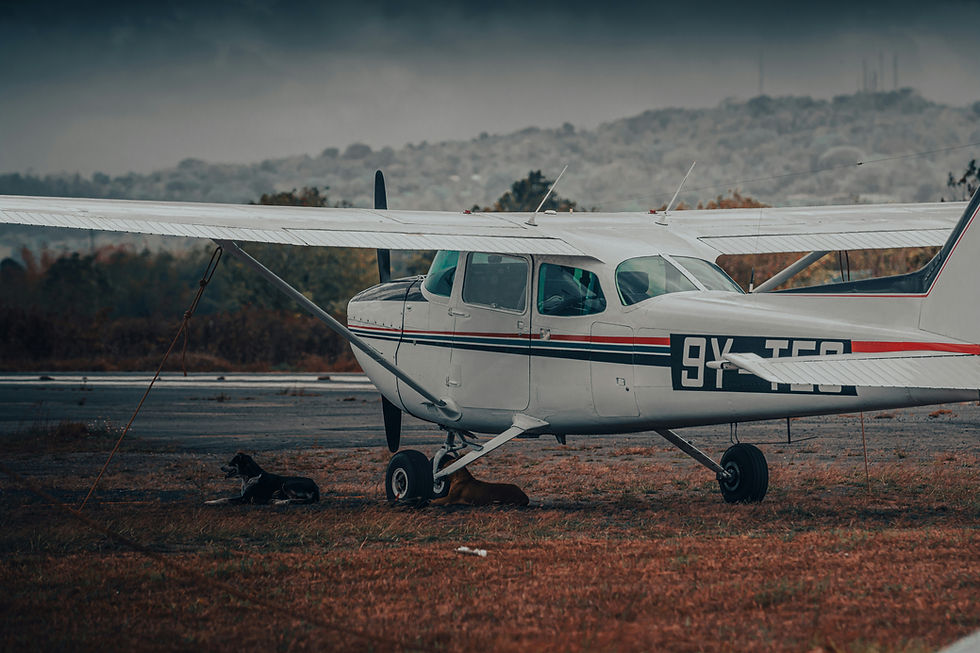How to Smartly Arrange Funds for Your Dream Pilot Training Journey in India
- Ishansh Sachdeva
- Jun 29
- 4 min read
Becoming a pilot is a dream cherished by many aviation enthusiasts across India. The thrill of soaring through the skies is simply irresistible! However, one of the biggest challenges aspiring pilots face is arranging the necessary funds for pilot training. While the journey to the cockpit can be expensive, you can secure the funds you need to make your dream a reality with the right strategies. In this article, we’ll explore various practical ways to arrange funds for your pilot training journey in India.
Understanding the Costs of Pilot Training
Before diving into funding options, understanding the costs associated with pilot training in India is essential. The overall expense varies based on the type of license pursued, whether it’s a Private Pilot License (PPL) or a Commercial Pilot License (CPL).
Training costs typically range from INR 40 to 70 lakh, depending on the flight school, duration of training, and any additional licenses or ratings required. For example, a CPL program might take around 12 to 18 months and could cost anywhere from INR 40 to 70 lakh. Knowing your financial needs allows you to strategize effectively.
Explore Scholarships and Grants
One of the smartest ways to reduce the financial burden of pilot training is by applying for scholarships or grants. Various organizations, both government and private, offer financial assistance to aspiring pilots.
To maximize your chances, research local pilot training institutes and reach out to them to gather information about available scholarships. This step can significantly ease your financial journey.
Research government schemes at central and state level, Governments do provide scholarships in some cases.
Educational Loans from Banks and Financial Institutions
If scholarships alone do not meet your needs, the next step is to consider educational loans. Many banks and financial institutions in India offer loans specifically for pilot training.
Important Considerations:
Compare Interest Rates: Banks often offer different interest rates and repayment terms. For instance, rates can range from 9% to 14%. Shop around and compare these rates before deciding.
Prepare Documentation: Banks typically require documentation such as admission letters, a detailed fee structure, and your academic records, so have these ready.
Check Eligibility: Some banks may offer loans only to students accepted into recognized pilot training institutes, so verify these conditions beforehand.
Educational loans not only cover training costs but can also help with living expenses during your training program, which is crucial in managing your finances effectively.
NOTE : Getting 100 % loan for pilot training is possible but not recomended.
We suggest a minimum of 30% cash in hand. For free financial counselling reach out to us.
Part-Time Job Opportunities
While pursuing pilot training, consider taking up part-time jobs or internships. Although balancing work with training may seem daunting, any additional income can significantly assist in covering expenses.
Opportunities to Consider:
Teaching Assistant: If you excel in subjects like mathematics or physics, assisting in ground school training can offer both financial rewards and valuable experience.
Aviation-related Jobs: Explore internships or part-time work at local airfields or aviation startups. These roles provide income while you gain industry experience.
Freelance Work: Depending on your skills, freelancing can be a flexible way to earn extra cash without strict time commitments.
These part-time opportunities can alleviate financial strain and enhance your resume as you prepare for a career in aviation.
Family Support and Financial Advisors
Do not overlook family support when planning your finances. Talk to your parents or relatives about your aspirations. Many might be willing to help, whether through direct financial support or co-signing loans.
Moreover, consulting a financial advisor can provide tailored insights on budgeting and investment strategies for aspiring pilots. They can help you create a roadmap highlighting steps to reach your funding goals effectively.
Budget Management and Planning
Effective budgeting is crucial no matter which funding route you choose. Create a detailed budget outlining all financial resources and anticipated expenditures.
Budgeting Tips:
Track Your Expenses: Maintain a record of training-related expenses to analyze your spending patterns. This practice helps identify areas where you can cut costs.
Set Saving Goals: As you earn, allocate a portion of your income specifically for your training. Saving even a small amount each month can add up over time.
Limit Unnecessary Expenses: Being mindful of your spending helps maximize savings, especially during such a significant financial commitment.
Learning From Others
Connecting with fellow aspiring pilots or those who have completed their training can be beneficial. Their experiences can offer valuable insights into funding options and strategies that have worked for them.
Join online forums, social media groups, and local aviation clubs to network with fellow pilots. These connections can provide inspiration and information on managing finances for pilot training.
Your Path to the Skies
Arranging funds for your pilot training journey in India may seem daunting, but it is achievable with the right strategies. Whether applying for scholarships, securing educational loans, or exploring crowdfunding, numerous avenues are available to support your goals.
Maintaining a positive attitude and staying focused is essential. Persistence and smart planning are your allies in overcoming financial hurdles. The skies await you!

If you’re ready to leap into aviation education, create a plan, pursue your passion, and you will soon find yourself in the cockpit—realizing your dream of flying!




Comments